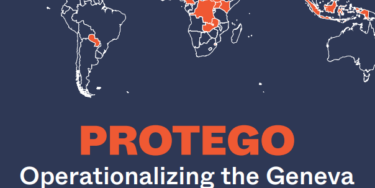To celebrate the release of the YPplus10 and to highlight its relevance for our different communities, from today GATE is publishing a series of briefings related to different aspects of the document. Their first briefing focuses on intersex issues.
Background
The Yogyakarta Principles[1] were first created in 2006, primarily at an expert meeting in Yogyakarta, Indonesia. The intention was (and remains) to apply international human rights law to sexual orientation and gender identity. The new 2017 Supplement extends the Principles to formally also include sex characteristics and gender expression.
Representation
There was only one intersex activist at the expert meeting in Yogyakarta: Mauro Cabral Grinspan. For the 2017 Supplement, Mauro (now of GATE) and Morgan Carpenter (OIIAU and GATE) were part of the drafting committee. Many other human rights and legal experts joined a new expert meeting in Geneva, in September 2017. Those participants came from all around the world, and from intersex, trans, LGBT, and other backgrounds; they included Kimberly Zieselman (interACT).
Protection from medical abuses
The original Principles mention intersex in the preamble, and make reference to a range of rights that benefit all people, including intersex people, on grounds of sexual orientation and gender identity. Principle 18B seeks to end human rights violations in medical settings. However, the language of the original Principles did not meet the aspirations of the intersex participant, and Principle 18B is constrained by the simplistic way it referenced the child’s best interests. In recent years, the UN has recognised that the concept of best interests can (and has been) manipulated,[2] and used to justify cruel or degrading treatment and violations of the right to bodily integrity.[3]
Impact and goals
While widely cited in relation to the rights of people of diverse sexual orientation and (to a lesser extent) gender identity, the Principles have had even less impact in promoting the rights of intersex people.
Given the importance of the Principles in establishing the rights of people on grounds of sexual orientation and gender identity, we hope that the Supplement will promote the rights of all people on grounds of sex characteristics, and gender expression. The 2017 review aims to be feminist, intersectional, and fully reflect the needs of (overlapping) intersex and trans populations.
The Principles are a tool that people and organisations can use in advocacy. There is nothing obligatory about them, but we hope that they will encourage better recognition of intersex human rights issues by people who use a SOGI framework, and encourage adoption of SO/GIE/SC lenses.
The ground of ‘sex characteristics’
The Supplement defines sex characteristics in this way:
UNDERSTANDING ‘sex characteristics’ as each person’s physical features relating to sex, including genitalia and other sexual and reproductive anatomy, chromosomes, hormones, and secondary physical features emerging from puberty;
This definition provides a powerful tool for the recognition of the rights of people in the context of changes to sex characteristics, and discrimination on the basis of sex characteristics. The term ‘sex characteristics’ is already used to define intersex and tackle violence and discrimination against intersex bodies. The term already appears in popular and widespread definitions of intersex, such as those produced by the UN:
Intersex people are born with physical or biological sex characteristics (such as sexual anatomy, reproductive organs, hormonal patterns and/or chromosomal patterns) that do not fit the typical definitions for male or female bodies. For some intersex people these traits are apparent at birth, while for others they emerge later in life, often at puberty.[4]
A definition of sex characteristics was also written into law in Malta in 2015, providing a first legislative protection for children from forced modifications to sex characteristics.
The definition of sex characteristics in the YP is universal – it applies to everyone, as everyone has some combination of sex characteristics, including both innate and acquired sex characteristics. Intersex characteristics are problematised prenatally, at birth and in childhood, adolescence and even adult life. Genital mutilation and trauma change sex characteristics. Not all changes are human rights violations: gender affirmation surgery also changes sex characteristics.
Legislative protection on grounds of sex characteristics can protect from human rights violations and it can also protect from discrimination.
The term does not require that people use the word ‘intersex’ to describe themselves. It is not associated with any specific legal sex classifications or gender identities. By encouraging specificity about what is meant by sex, ‘sex characteristics’ can promote better language about what it means to be born with an intersex variation, and our diversity.
The new principles and state obligations
Preamble
The preamble defines sex characteristics. It also recognises the distinct needs, characteristics, and human rights situations of different populations on grounds of sexual orientation, gender identity, gender expression and sex characteristics. It recognises that the needs, characteristics and situations of intersex people thus differ from those of gay men. The preamble also recognises other intersectionalities, including due to racialisation, and Indigeneity.
Principle 31: The right to legal recognition
This principle calls for an end to sex/gender registration and inclusion in legal identification documents. This is based upon International Covenant on Civil and Political Rights article 24 and Convention on the Rights of the Child article 7.[5] These articles call for the registration of children with a name and a right to acquire a nationality. This might seem radical, but the International Covenant on Civil and Political Rights was signed back in 1966 and neither the Covenant nor the Convention require registration of any ‘biological’ characteristics.
The Principles outlines interim measures while legal systems require sex/gender on identification documents, including simple administrative mechanisms to change classifications, and recognition of multiple gender markers.
Principle 32: The right to bodily and mental integrity
This principle recognises that forced and coercive medical practices violate human rights principles on freedom from torture, cruel, inhuman and degrading treatment (a principle which includes freedom from experimental treatment). It also recognises that such practices violate to the right to bodily integrity, a right that derives from the right to personal security. The principle requires free prior and informed consent except in situations of urgent necessity for medical treatment. It calls on governments to combat the stigma and stereotypes that underpin treatment.
The Principles also seeks to manage problems with ‘best interests’ test, and calls for independent counselling.
Principle 37: The right to truth
This principles builds on rights established to combat impunity,[6] including an individual’s right to the truth about their medical history and access to redress, reparations and restorative treatments; to systemic rights to preserve memory and guarantee the right to know.[7] The Principle calls for this to not be subject to statutes of limitations.
Other principles
The Principles already call for access to healthcare, including gender affirming healthcare. They also call for rights to protection from poverty (34), the right to sanitation (35) including access to toilet facilities, and the enjoyment of information and communication technologies.
State obligations
A number of State Obligations have a direct and immediate relationship to the human rights situation of intersex people:
- An obligation to provide reasonable accommodations (2G) recognises that some intersex and other people may need support in education, employment and other contexts, whether due to acquired or innate health issues.
- An obligation on prenatal interventions (2L-M) calls for an end to prenatal treatments and genetic selection that discriminate against intersex people on grounds of sex characteristics. This language reflects similar statements on the role of sex selection in discriminating against women.[8] The State obligation doesn’t call for prohibition of such technologies, because it is limited to existing norms in international human rights law. Recognising that human genetic modification is becoming technologically feasible, this is anticipated.[9]
- The same concerns about current norms in international human right law mean that the Principles do not call for a right to marriage equality; the right to abortion and post-abortion care (33B and 17P) also match the best available international jurisprudence.
- Discrimination in sport (2I-K; Additional R).
- Recognise that forced modifications of sex characteristics may amount to torture (10D-E).
- Access to educational resources (16J, 17S).
- Disaggregation of data (19I).
[1] Read the first Yogyakarta Principles and the YP+10 supplement at: http://yogyakartaprinciples.org
[2] Committee on the Rights of the Child. General Comment No. 14 (2013) on the right of the child to have his or her best interests taken as a primary consideration (art. 3, para. 1). 2013. Report No.: CRC/C/GC/14, para. 34. Available from: http://undocs.org/CRC/C/GC/14
[3] Committee on the Rights of the Child. General Comment 13: Article 19: The right of the child to freedom from all forms of violence. 2011. Report No.: CRC/C/GC/13, para. 54. Available from: http://undocs.org/CRC/C/GC/13
[4] Office of the High Commissioner for Human Rights, African Commission on Human and Peoples’ Rights, Council of Europe, Office of the Commissioner for Human Rights, Inter-American Commission on Human Rights, Special Rapporteur on torture and other cruel, inhuman, or degrading treatment or punishment, Special Rapporteur on the right of everyone to the enjoyment of the highest attainable standard of physical and mental health, et al. Intersex Awareness Day – Wednesday 26 October. End violence and harmful medical practices on intersex children and adults, UN and regional experts urge. 2016. Available from: http://www.ohchr.org/EN/NewsEvents/Pages/DisplayNews.aspx?NewsID=20739&LangID=E
[5] United Nations. International Covenant on Civil and Political Rights. 1966. Available from: http://www.ohchr.org/EN/ProfessionalInterest/Pages/CCPR.aspx; United Nations. Convention on the Rights of the Child. 1989. Available from: http://www.ohchr.org/Documents/ProfessionalInterest/crc.pdf
[6] Orentlicher D, Economic and Social Council. Report of the independent expert to update the Set of principles to combat impunity, Diane Orentlicher Addendum Updated Set of principles for the protection and promotion of human rights through action to combat impunity. UN Commission on Human Rights; 2005 Feb. Report No.: E/CN.4/2005/102/Add.1. Available from: http://undocs.org/E/CN.4/2005/102/Add.1
[7] World Conference against Racism, Racial Discrimination, Xenophobia and Related Intolerance. Durban Declaration and Programme of Action. 2001, para 98. Available from: http://www.un.org/WCAR/durban.pdf
[8] Toebes B. Sex selection under international human rights law. Medical Law International. 2008;9(3):197–225. Available from: http://www.rug.nl/research/portal/publications/sex-selection-under-international-human-rights-law(306b9838-c767-4c3b-9daf-c33be0168f24).html
[9] Ledford H. CRISPR fixes disease gene in viable human embryos. Nature News. 2017 Aug;548(7665):13. Available from: http://www.nature.com/news/crispr-fixes-disease-gene-in-viable-human-embryos-1.22382
Download PDF


